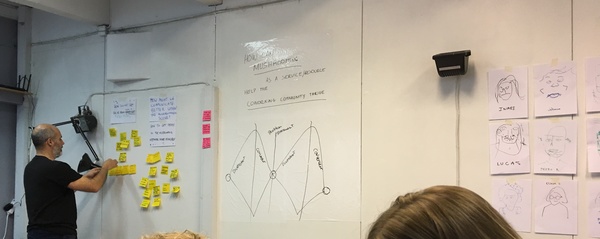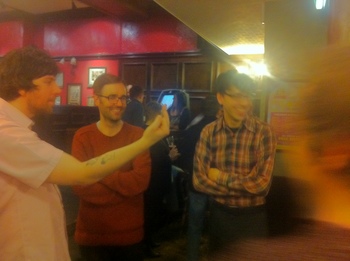Followup to my open letter to the minister of culture
Yesterday, I wrote an open letter to the incoming Estonian culture minister, and against my better judgement I shared it on Facebook. What resulted was not surprising - a plethora of ‘likes’ from friends, and it was shared by about ten other people to wider audiences.
What disappointed me was that I wrote the piece not to actually communicate with the culture minister (I’m sure she has better things to do than read icewhistle.com) but to hopefully start some sort of public discussion about the issues I raised. There were some comments on my own “wall”, and the start of a discussion, but almost entirely coming from Finns and other non-Estonians.
Even more disappointing is that in the Eesti kunstielu arengusuunad Facebook group, where I also posted the letter, there were zero comments (though a handful of ‘likes’). I certainly don’t expect anyone in Estonia to care what I have to say, and if there is to be any sort of discussion on these topics, I don’t expect it to be in English. But isn’t the purpose of a 1000+ private Facebook group of Estonian art scene people to communicate and discuss? I can’t help but feel this is a metaphor for the general sense of frustration I’ve felt while attempting to create participatory culture events in Tallinn. The locals are interested and sympathetic, but not interested in communicating as such with me or other foreigners - or with each other?
I don’t want to turn this into an “Us vs. Them” situation as that would be reductive and insulting, but the private feedback I received from friends was very curious. Estonian friends appreciated my elocution but asked me to provide concrete examples. Non-Estonian friends saw it more as I intended - as a broad, open call for others to share their ideas.
So here’s some examples.
In 2011, when I moved to Estonia, I was buzzing with ideas about the intersection of art and economics. I had just met Christian Nold at Pixelache 2011 and I was completely blown away by his projects involving alternative currencies. My new home of Estonia had just switched to the Euro and everyone I talked to was cynical about this change, fearing inflation (which totally happened). I dreamed that the few cultural organisations I knew in Tallinn could somehow connect themselves and create something like what Christian had done in Amsterdam: first a currency, tomorrow an entire alternative economic system! This seemed not only possible, but logical, as my view of Tallinn (then) was that institutions were much more flexible and grassroots-orientated than anything in Helsinki.
Why couldn’t we create an economy that was shared among not-for-profit art and culture projects? The advantages to such an idea are numerous and don’t need to be discussed here. I talked about it forever but never was able to dedicate much time to it, as I was busy getting Ptarmigan Tallinn launched, followed by Tiib and Slothrop’s. Finally, in May 2012, I organised an evening to discuss the idea, with presentations by Christian Nold, Rainer Eidemiller from the Paide P.A.I. project, and Kaspars Lielgalvis from Totaldobze in Riga (all three who have created alternative currency systems). After the presentations we had an open discussion about how this could possibly be implemented in Tallinn.
What followed was simultaneously my all-time favourite Ptarmigan event and also the most fantasy-destroying. I realised how quixotic and naive this idea was. The institutions in my cultural axis (for example: Ptarmigan, Polymer, Kanuti Gildi Saal, EKKM, Uus Maailm, etc.) are nowhere near being able to implement something as complex as a shared economic structure. At the moment, it feels like they are barely able to collaborate creatively. This is not through any sort of malice or bad politics, but through the essential reality of how competitive and unrewarding arts management is in Tallinn, at this so-called “grassroots” level.
Which makes such an idea all the more necessary. We are hopelessly spiraling towards our own undoing, continuing to overextend ourselves in an attempt to hold on to whatever tiny precipice of support we still have (which is still disappearing). We are constantly sacrificing our well-being, showing that we are capable of ‘in-kind financing’ by cutting corners and doing anything possible to fight for an increasingly more tiny piece of the Kulka pie. Or, we turn to creative industry as our answer. (Or, in the case of KultuuriKatel, we chase a carrot continually dangled from a stick).
(By the way, I have nowhere near given up on strategising about alternative economic models -- in fact, it occupies most of my idle thoughts. My work with the Robin Hood Minor Asset Management project is one such possibility and I hope that project can grow and find new members. End plug.)
What I wrote to the minister is my hope that we can change the dialogue, or at least start one. Yes, I think the ministry of culture should invest money into creating structures, not just end-products. These structures will benefit more than one individual or organisation if they encourage communication, collaboration and openness. The idea of printing an alternate currency and using it between arts spaces is just one possible structure. It would be an experiment, and maybe it would fail. But as a socialist I see the role of government as to help society. Certainly EAS hands out massive amounts of funding to private business enterprises which are just as risky. The government should support experimentation, not just aesthetically but in the structures that create the aesthetics.
Here’s another idea: establish a system of tax breaks for property owners who rent their properties to organisations for the purpose of non-profit art and culture. Here’s another one: establish a regular weekly meeting point for artists, socially focused entrepreneurs and culture producers, which has no fixed agenda or leaders or budget - just a place where people can open up, chat, and communicate. Here’s another one: encourage organisations to create a board of outsiders - invite members from other organisations to visit you every few months and share your thoughts and plans. (We do something like that at Pixelache with our "expert board"). Here’s another one: create an unconference for artist-run organisations from all three Baltic states.
These are all just off the top of my head, or ideas I have kicked around for years and never attempted. Again, I’m an outsider to this world, an American whose projects are of limited interest and too post-subcultural for the very traditional view of art in Estonia. So I don’t expect anyone to want to talk to me: ma ei räägi Eesti keeles. I’m not demanding that we stop funding white cube galleries, performances, concerts, or what the majority of art funding gets spent on; I don’t expect Kulka to start funding my social provocations (and I’ve stopped bothering to apply). I just hope that conversations can start somewhere.
The Internet and social networking has given us 50 million different places to communicate. But does anyone have anything to say?





